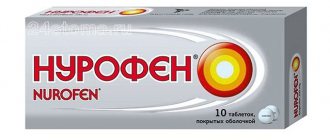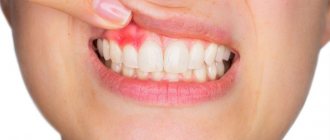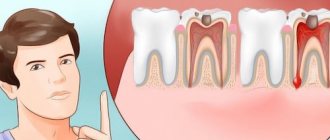Temporary fillings in dentistry are used for a variety of purposes, but mainly at intermediate stages of root canal treatment, as well as dental prosthetics.
In this article we will focus on root canal treatment and the use of temporary fillings with all known arsenic.
It is worth noting that the use of arsenic, as such, is becoming rare in modern dentistry. Since this material itself is extremely toxic and its improper use can cause great harm. Today, arsenic-free pastes that are used for the same purpose as arsenic are more relevant.
Is it possible to put arsenic in a tooth?
Arsenic is a chemical element that belongs to immunotoxic substances, that is, poisons.
It disrupts the exchange of selenium, sulfur and phosphorus in tissues, which leads to a lack of oxygen, hypoxia and, as a result, cell death. In dentistry, it is not pure arsenic that is used, but a paste with arsenous acid anhydride in combination with various anesthetic and antiseptic components. Below, by arsenic we will mean a paste, and not a pure chemical element.
The toxin was first used for dental treatment in 1836. Nowadays, treatment methods have changed significantly, but in some cases dentists still use acid.
In the article Stom-Firms.ru we will tell you why arsenic is placed in the tooth during treatment. We will describe how and for how long it is placed, and also list the complications that may arise.
Where should stool analysis be stored until the morning from the evening
Exclusively in the refrigerator compartment. We recommend sending the container immediately after collection. It is advisable to choose special sterile containers.
How to store stool for analysis in the evening:
- Biomaterial must be collected naturally. You cannot use enemas or laxatives for three days. It is prohibited to insert glycerin suppositories. All this distorts the result;
- The feces are immediately transferred to a sterile container. It is unacceptable to use dirty containers or large dishes.
- The lid must be screwed on tightly. Matchboxes are a thing of the past. Only use a sealed container.
- We recommend placing the jar on the middle shelf. Remove other products further. The compartments in the refrigerator door where lens solution, potassium permanganate, and iodine are stored are not suitable.
It is advisable to protect the container from sunlight. The jar can be wrapped in a dark bag. Place in another bowl. It will help lock the smell inside securely. Another important point is that the contents will not scare household members.
Indications and contraindications for the use of arsenic
Arsenic acid is used for devitalization, that is, killing the dental pulp in order to then partially or completely remove it. Before the development of anesthesia, this was the only way in which it was possible to remove a tooth relatively painlessly, cure pulpitis and some other dental diseases.
Now the pulp is removed under local anesthesia and using drugs without arsenic. But there are indications according to which he is still placed. These include:
- Acute diffuse or chronic fibrous pulpitis;
- Chronic hypertrophic pulpitis in teeth with impassable and curved canals;
- Allergy to local anesthetics;
- Severe general condition, for example, after a heart attack or stroke;
- Inability to open the mouth wide due to contraction of the lower jaw.
Dentists emphasize that arsenic is not an alternative to pulp removal with anesthesia. The toxin is used as a last resort when the patient has indications for it.
Arsenic should not be placed in the dental cavity if:
- Allergies to paste components;
- Pregnancy and lactation;
- Increased eye pressure;
- Diseases of the urinary system;
- Unformed roots.
In pediatric dentistry, arsenic should not be administered to children under 1.5 years of age. But today, paste with arsenic acid is practically not used to treat pulpitis in a child. Pulp devitalization is carried out with other drugs.
Is it possible to freeze marinated meat?
Freezing marinated meat becomes a necessity when insurmountable circumstances force you to postpone the date of the picnic. In order not to throw away already marinated meat, you have to look for ways to preserve it in a form suitable for consumption.
When the picnic is postponed for a long time, which does not allow storing the meat in the refrigerator, it is frozen. This method is not ideal, but it is an excellent way out of this situation.
Freezing Features:
- The easiest way is to freeze a product where products with a small amount of acid (tomato paste, tomatoes, other sauces), mineral water, and a small amount of vinegar were used for marinade;
- Freeze by placing the meat in a container made of plastic or vacuum bags (pour the marinade there);
- defrost the kebab gradually before frying; the day before, move it from the freezer to the bottom shelf of the refrigerator;
- Forcibly defrosting meat (in a microwave oven, hot water) is prohibited; the juiciness of the product will be preserved only with gradual thawing.
Is it possible to freeze marinated meat in mayonnaise?
Mayonnaise marinade is considered not the best option for marinating meat products. After storage in the freezer, when the product is defrosted, its components lose their appearance, resembling coagulated protein.
After freezing, you may be upset by the uneven consistency: you can solve the problem by rinsing the pieces with cool water and preparing a fresh marinade, put the meat there for a couple of hours. If you have doubts about quickly frying kebabs, use mineral water, sunflower oil, and tomato paste for marinating. These products do not in any way affect the taste of the product after it has been defrosted.
Is it possible to freeze marinated chicken?
Once the chicken is in the marinade, it can be frozen. Place the product in a convenient container and put it in the freezer. It is advisable that the future kebab should contain onions; after defrosting, they give off an unpleasant smell. Remove the onions in the marinade before freezing; after defrosting the product, add fresh onion rings to the chicken.
It is not forbidden to freeze finished poultry shish kebab. Place the meat in a container and cover with cling film. The product should be defrosted in natural conditions, heated in an oven or microwave.
Is it possible to freeze marinated meat with onions?
Most well-known marinades include onions, herbs, and other spices. After defrosting a product containing these components, their appearance is lost. The onion stops crunching and acquires an unpleasant smell.
Before frying defrosted meat, remove onions and herbs.
After thawing the kebab, make a new marinade. The meat should lie there for a couple of hours, then start frying. This approach will preserve the taste of the meat, leaving the herbs, onions, and other seasonings unchanged.
Is it possible to freeze marinated pork meat?
Freezing almost finished kebab - raw meat lying in the marinade - is possible, but it is irrational when it is planned to fry it in the near future. The pork can marinate for a couple of days while on the refrigerator shelf.
Features of storing pork meat in the freezer:
- put the kebab in a plastic container, close the lid;
- place the container in the freezer;
- There is no need to defrost before cooking, immediately place the kebab on the grill and brown on both sides;
- bring the product to readiness.
Which kebab should not be frozen?
Not all types of marinades are suitable for frozen storage. Experts do not recommend subjecting some of them to such manipulations.
Marinade containing herbs should not be frozen. After the defrosting process, it will lose color, become tasteless, and darken. When there are suspicions that the kebab will not be able to be fried at the planned time, greens are not added to the marinade. This can be done at any time when the decision about a picnic has not changed.
Experts generally do not recommend adding greens to kebabs; on the grill they char, burn, and spoil the appearance of the dish. It is much better to serve the finished product, framing it with fresh leaves of dill, parsley, and cilantro.
In addition to greens, chicken and beef are not frozen. Both of these products, after bringing them to normal, lose their taste and change in appearance.
How to put arsenic in a tooth
Depending on the age of the patient, the condition of the pulp and the size of the tooth, the doctor determines how much paste is needed. Typically, its amount varies from 0.0002 to 0.0004 mg.
Let us describe the stages of the procedure:
- The dentist uses an excavator to remove food debris, damaged tissue and thinned dentin from the carious cavity;
- A ball-shaped paste is placed on the pulp horn and covered with a bandage;
- Hermetically seals the cavity with a temporary filling.
Sometimes doctors put the paste on the unopened pulp. Then, after the procedure, the tooth may be very painful, especially when pressed, because swelling occurs and pressure in the tissues increases.
Usually, adults put arsenic in single-rooted teeth for 24 hours, in multi-rooted teeth for 2 days, but this period can increase to 6 days depending on the manufacturer and brand of the drug. Then the patient comes back for an appointment, and his pulpitis is treated in the traditional way: the temporary filling is removed, the cavity is prepared, the pulp is removed or amputated, the canals are processed and sealed.
Composition of temporary filling
The main difference between temporary fillings and permanent fillings is their composition. They are usually made from the following materials:
- Artificial dentin. This is a mixture of zinc oxide and sulfate powders with distilled water.
- Vinoxol. It is a mixture of zinc oxide powder and liquid. It has good adhesion and antiseptic properties, and due to its high strength, a temporary filling made from this material can last up to six months.
- Dentine paste. White homogeneous mass with essential oils. The material is plastic, has excellent adhesion, and has water-repellent properties.
- Zinc-eugenol cement. It contains zinc oxide and clove oil or the fragrant substance eugenol. A temporary filling made from this material has good adhesion, an analgesic effect, antiseptic properties, and resistance to increased loads.
- Polycarboxylate cement. It is a mixture of zinc oxide powders, copper and liquid. It has good ductility, resistance to moisture, and excellent adhesion.
- Karyosan - zinc oxide with eugenol.
All materials have their own hardening time and the period after which food can be eaten. For each case, the dentist himself determines the type and composition for filling the cavity, which will affect the price of the temporary filling.
What to do if complications arise when using arsenic
If the doctor correctly selected the dosage and hermetically installed the temporary filling, and the patient came for a follow-up appointment on time, there will be no complications after using the paste. They occur if the therapist used too much of the substance, did not install the filling tightly and it fell out, or when the patient missed the deadline for taking it and walks with arsenic longer than expected.
The most common complications include:
- Burn of the mucous membrane, for example, gums;
- Necrosis of surrounding tissues and pulp of adjacent teeth;
- Arsenic periodontitis and periodontitis;
- Osteonecrosis is the destruction of jaw bone cells.
If arsenic falls out, the patient has a headache, feels sick and vomits, contact the clinic immediately. When the poison enters the body, the doctor administers an antidote. In case of damage to the mucous membrane, treat the affected area with antiseptics and drugs that block the spread of the toxin and accelerate tissue epithelization.
In modern dentistry, to avoid overdose, the paste is produced in special granules. The main thing that doctors urge is not to overexpose arsenic: keep it for as long as you are prescribed to walk with it. Then the risk of complications becomes minimal.
Does it hurt?
In most cases, the process of pulp necrosis using arsenic is painless. This is due to the pain-relieving components that are present in the arsenic paste. Sometimes patients complain of moderate pain, and this is normal. If you are experiencing severe pain, we recommend that you immediately visit the dentist.
Significant pain is possible if the dentist violated the rules for performing this procedure, for example, put too little arsenic.
More information on the topic
When they use arsenic and why, you will learn even more in the articles:
- Deep caries
- Treatment of periodontitis
- Dental prosthetics
References for the article:
- Kostina I.N., Nikolaeva A.A. “Arsenic necrosis of the jaw - complications in the treatment of dental pulpitis” // “Problems of Dentistry” No. 3, 2010.
- "Endodontics. Pulp diseases" // Textbook / A.S. Opravin et al. – Arkhangelsk: Publishing House of the Northern State Medical University, 2021.
Is it possible to collect stool for testing in the evening?
Evening gathering is actively practiced. Only suitable for single types of diagnostics - identification of certain helminths. When collecting in advance, it is advisable to choose late evening time. For delivery by 8am, you must collect no earlier than 8pm.
Most methods allow you to obtain the correct result exclusively on fresh biomaterial. Failure to comply with storage periods distorts the picture.
No biomaterial can be stored for 24 hours. Maximum period 8 hours. Then the chemical composition changes, the eggs and worms die and decompose.











